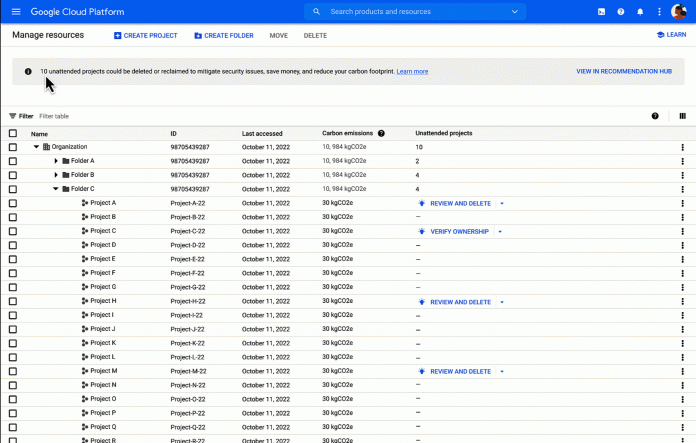Unattended Project Recommender makes identifying idle cloud projects easy, and helps you mitigate associated security issues, reduce unnecessary spend and environmental impact. In order to implement a scalable and repeatable resource lifecycle management process, it’s important to have the right tools for the job. Today, we’re announcing several new capabilities that can help you make idle project remediation a part of your company’s day-to-day operations and culture:
Organization-level aggregation of recommendations for a broader view of your unattended projects
Observation period configurability to give you more control into the usage windows
See the cost impact of following our recommendations
Shareable links so that you can distribute specific recommendations to others
Let’s take a closer look at each of these new features.
1. Organization-level view of recommendations
In Google Cloud, cloud administrators that are looking to cut costs, reduce their organization’s carbon impact, or clean up lingering security issues, can now use Resource Manager to find and address unattended projects. The summary banner at the top of the page, a new Recommendations column with counts of unattended projects per organization, a new column for Carbon Emissions, and the light bulbs next to unattended projects are there to help you achieve your goals.
On the command line and API, the new Organization and Billing Account-level endpoints allow users to issue a single list command that returns all unattended projects in the organization, or billed to the same account (documentation). Security-minded administrators can also use the command line or API to sort and address the recommendations based on the values of the priority field, which prioritizes unattended projects based on the highest priority security recommendation found within the project (documentation).
2. Observation period configurability
Previously, the Unattended Project Recommender looked for 30-days’ worth of consistent usage (or lack thereof) before producing a Recommendation. This minimum_observation_period is now configurable (usage documentation) via the Recommender API for the entire organization and can be set to predefined values from 30 up to 365 days. Organizations that look for a higher degree of confidence before applying unattended project recommendations, or those that have use cases for idling projects that are used very infrequently, are encouraged to change this configuration.
3. Cost Impact
In addition to being able to prioritize unattended projects by your carbon footprint, or by the level of security risk associated with unresolved Active Assist recommendations, you can now also see via the API how much cost savings you would obtain if you remove unattended projects (documentation). This makes it easier for you to find maximum cost efficiencies to sort and focus on the unattended projects that have the most cost impact.
Here’s what a response may look like with the cost impact field, displaying that removing this project will save 120 USD.
4. Making automation easier with shareable recommendations
While some cloud administrators may choose to apply recommendations in-bulk (e.g. delete all projects recommended to be removed), most cloud administrators prefer to delegate that work to the person, team or department that owns the project or is closest to it. Now recommendations that you see in Cloud Console UI come with a shareable link: you can click on the copy icon in the top right corner of the recommendation details page to copy the link to the recommendation and then share it with someone else, or even construct the link programmatically. Clicking the link takes the user to the details page of the recommendation you shared.
Get started today
We hope these new capabilities will help you implement a scalable and repeatable approach to resource lifecycle management. We recently published asolution for lifecycle management of unused projects that takes advantage of all these new capabilities, and we hope the patterns demonstrated there are useful for your approach. For further explorations, you can read our documentation, and start reviewing your organization’s unattended projects in Resource Manager or in Recommendation Hub.
We hope that you can leverage Unattended Project Recommender to improve your cloud security posture and reduce cost, and can’t wait to hear your feedback and thoughts about this feature! Please feel free to reach us at [email protected] and we also invite you to sign up for our Active Assist Trusted Tester Group if you would like to get early access to the newest features as they are developed.
Cloud BlogRead More


